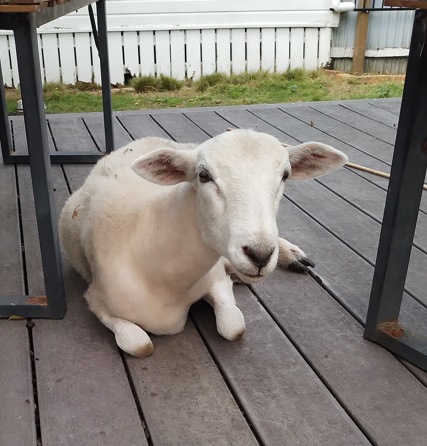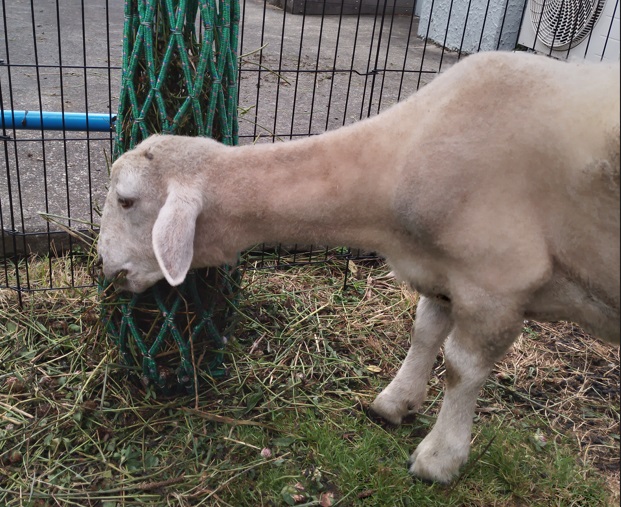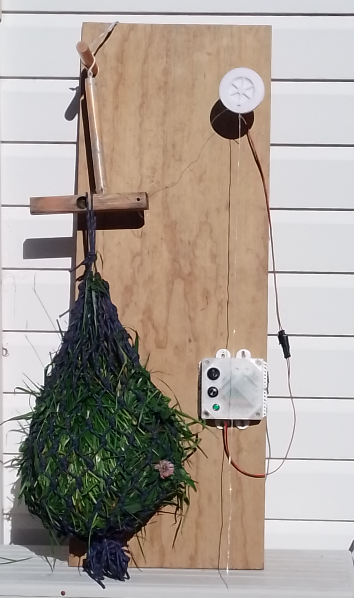The abundant rainfall in Waikato allows grass to grow luxuriantly almost all year round, making the landscape lush and green throughout the seasons. Inspired by this, we came up with the idea of raising sheep in our backyard. So, we purchased two Wiltshire ram lambs, around 1–2 months old, from TradeMe. This breed is known for its hardiness and low-maintenance nature.

Although the lawn grass grew rapidly, once the lambs arrived, their appetite and activity quickly overwhelmed the grass’s ability to recover. Within a month, I had to start mowing grass from outside every day to supplement their feed. After two months, their daily food depended almost entirely on grass cut from elsewhere.
At first, they were fearful and kept their distance. But we soon discovered that, contrary to our expectations, Wiltshire sheep were surprisingly lively, curious, intelligent, and brave. They were difficult to handle and even harder to confine.
One of them stood out as a natural leader—smarter, bolder, and the first to approach us during feeding. He quickly learned to bleat to get our attention. The shyer one followed his lead, eventually bleating too, but in a softer, more affectionate way.
We sweetly called them “Elder Brother” and “Younger Brother.”


We invested a lot of effort into reinforcing the gate and fence, building a wooden shelter to protect them from the wind and rain during Hamilton’s cold, wet winters, hiring someone to repair a dilapidated shed, and mowing grass and cleaning up sheep droppings almost every day or every other day.
But the joy of being with the sheep made all the effort worthwhile. When you stroke their soft wool or watch them quietly chewing grass, it feels as though all your worries melt away. Perhaps this is the gentle magic of this docile, social species.
One important takeaway was that we personally experienced the daily pain points farmers face. Since I had to work in an office during the day, I could only feed the sheep in the early morning and evening—there was no way to supplement their food in between. On winter mornings, it was freezing; in summer, the sun rose too early. The sheep would bleat and wake me up, and I had to drag myself out of bed to feed them. Those days were the toughest.
Before owning sheep, we had also volunteered at an equine-assisted therapy farm. There, we saw how the staff fed animals strictly on schedule every day. Despite their love for the animals, the rigid feeding times sometimes disrupted their work-life balance.

So I came up with the idea of a timed auto feeder. We could prepare the grass bags in advance, hang them high, and set a timer to let them drop automatically after a few hours. Wouldn’t that solve the feeding problem?
We imagined using a motor to release the grass bags by pulling. To maximize efficiency with minimal power, we designed the system so that the weight of the grass bag wouldn’t rest directly on the motor shaft. Instead, the bag is suspended from an inverted T-bar, allowing for natural balance. In this setup, the motor remains under little pressure when idle. When activated, the motor pulls a lateral line attached to the T-bar flange, tipping the bar and letting the grass bag slide down. A sufficiently long web on the T-bar can generate enough torque that even a low-voltage, low-power motor can lift heavy loads with ease.
With input and support from senior engineer friends, we developed both the hardware and software. I myself have 20 years of experience in embedded product development. The mechanical design went through multiple iterations using 3D printing, with a focus on achieving weather resistance and stable operation.
This was the original inspiration and motivation behind the founding of Canopio Limited and the creation of our auto feeder product.
Raising sheep gave me a kind of spiritual fulfillment I had never expected.
To find fresh, lush grass, I explored open fields and wildlands. Thanks to Waikato’s generous rainfall, I was rarely disappointed. In bad weather, I’d put on a waterproof and windproof coat to carry back heavy bags of grass. This was a completely new experience for someone like me, used to office work.
Each day started with checking the weather forecast to plan my mowing time. Life became more in sync with nature, more grounded in the rhythm of sunrise and sunset. This brought a deep sense of peace and regularity. Even when I no longer needed to mow, I’d still feel a quiet joy at seeing grass growing vigorously along the roadside—as if it were music, fragrance, or art. Watching the earth regenerate its greenery so quickly after cutting, I came to deeply feel the Earth’s endless generosity. I found new resonance in the old Chinese saying: “The Earth’s virtue is vast and nurturing; the noble one bears all with great virtue.”

Through this, I gained a deeper appreciation for the cultivation culture in my country. I finally understood why the farmers near my childhood hometown labored from sunrise to sunset with tireless energy: not only because nature returned what they gave, but also because it nourished their spirits in return.
By observing and interacting with the sheep, I gained a deeper understanding of social animals. Their reliance on a leader and their desire for security led them to tolerate dominant behavior—even when it occasionally resulted in serious conflicts due to hormones. Yet most of the time, they showed empathy and care toward one another.
When separated, the younger one cried harder. If a stranger approached and frightened him, the elder one would stamp his feet in protest, clearly trying to protect his “younger brother”—even though he himself wasn’t scared.
It reminded me that humans, too, are social animals. Compassion, heroism, the need for security, and the longing for emotional connection—these are the foundations of human society, written deeply into our DNA.
